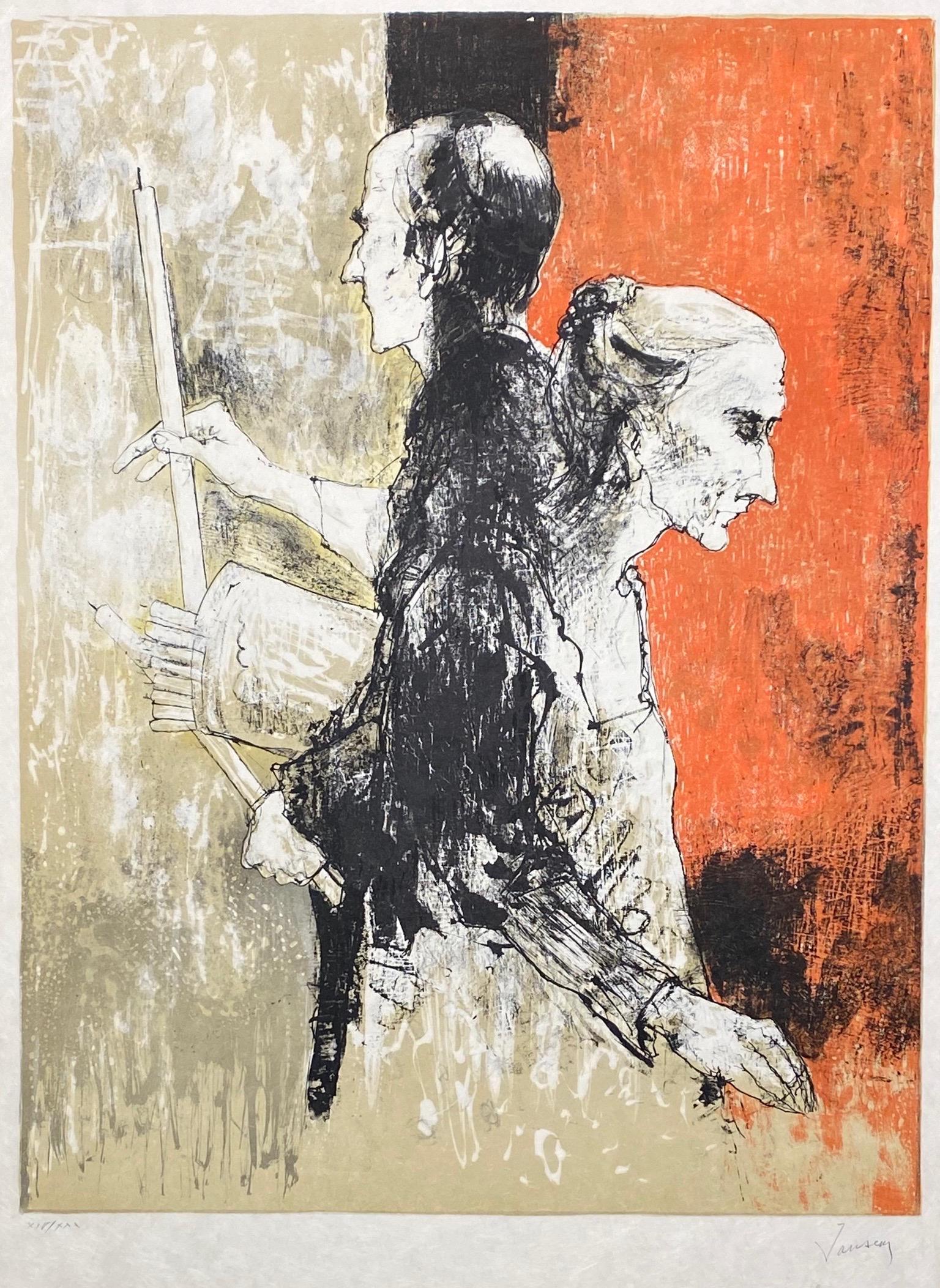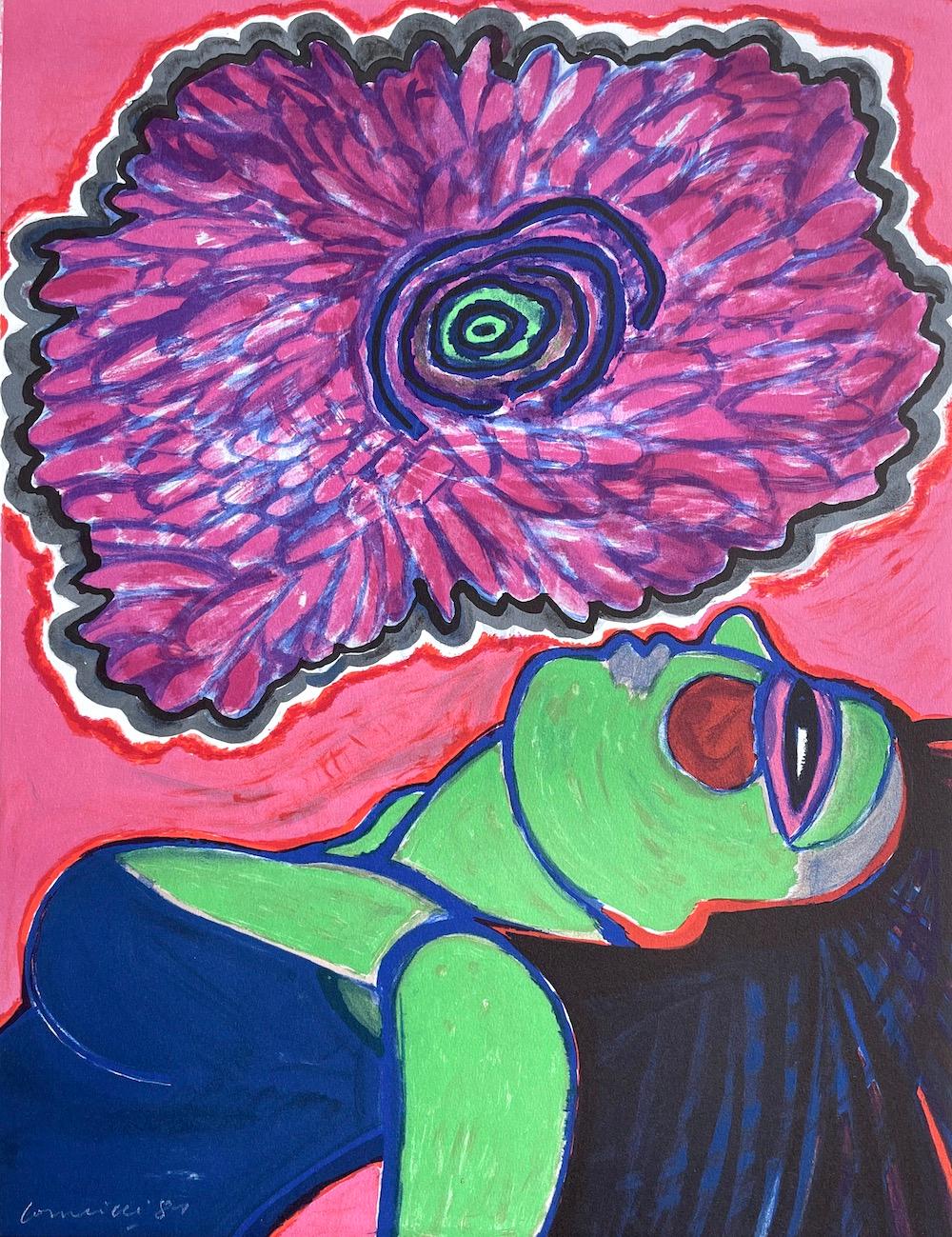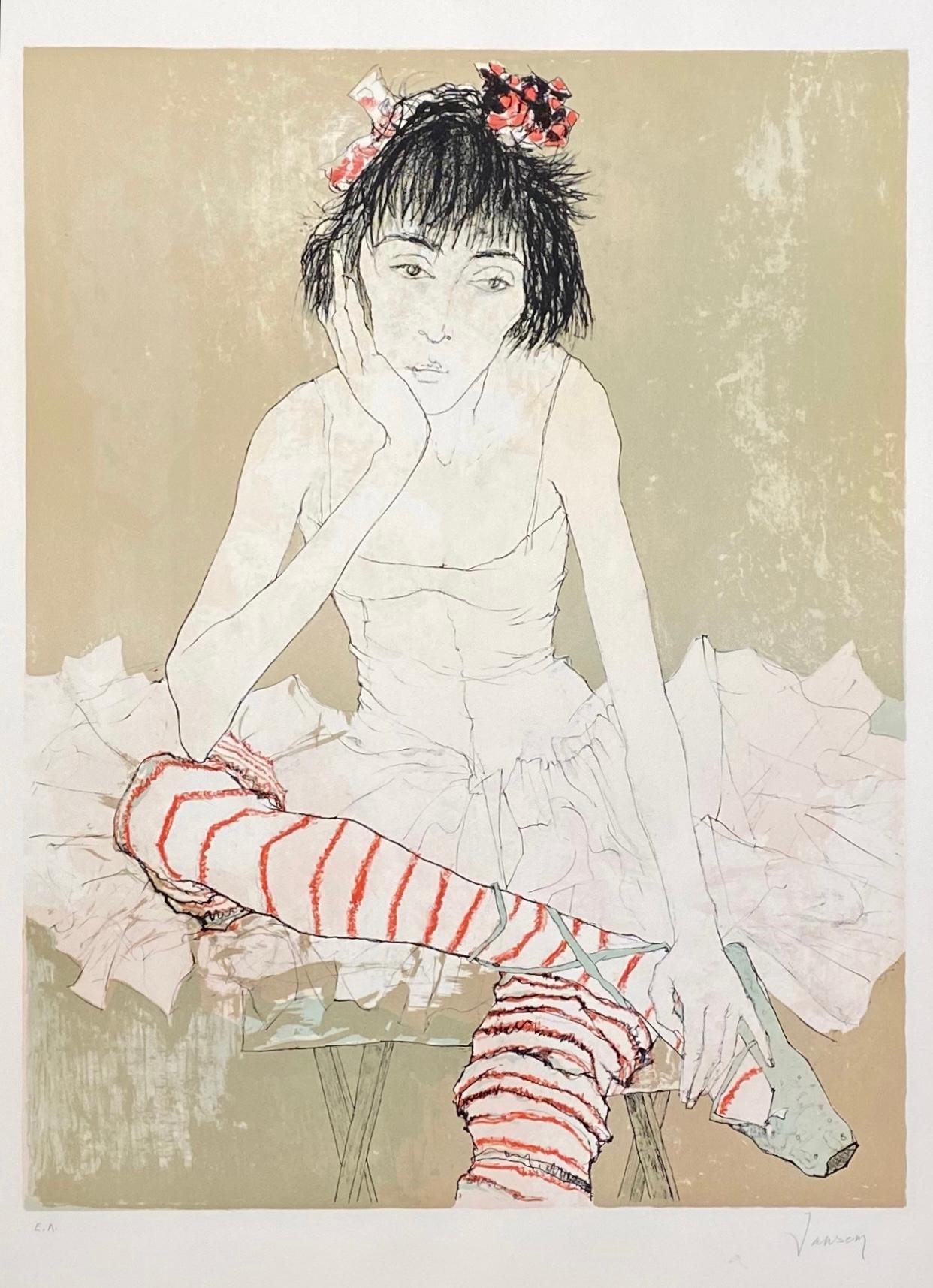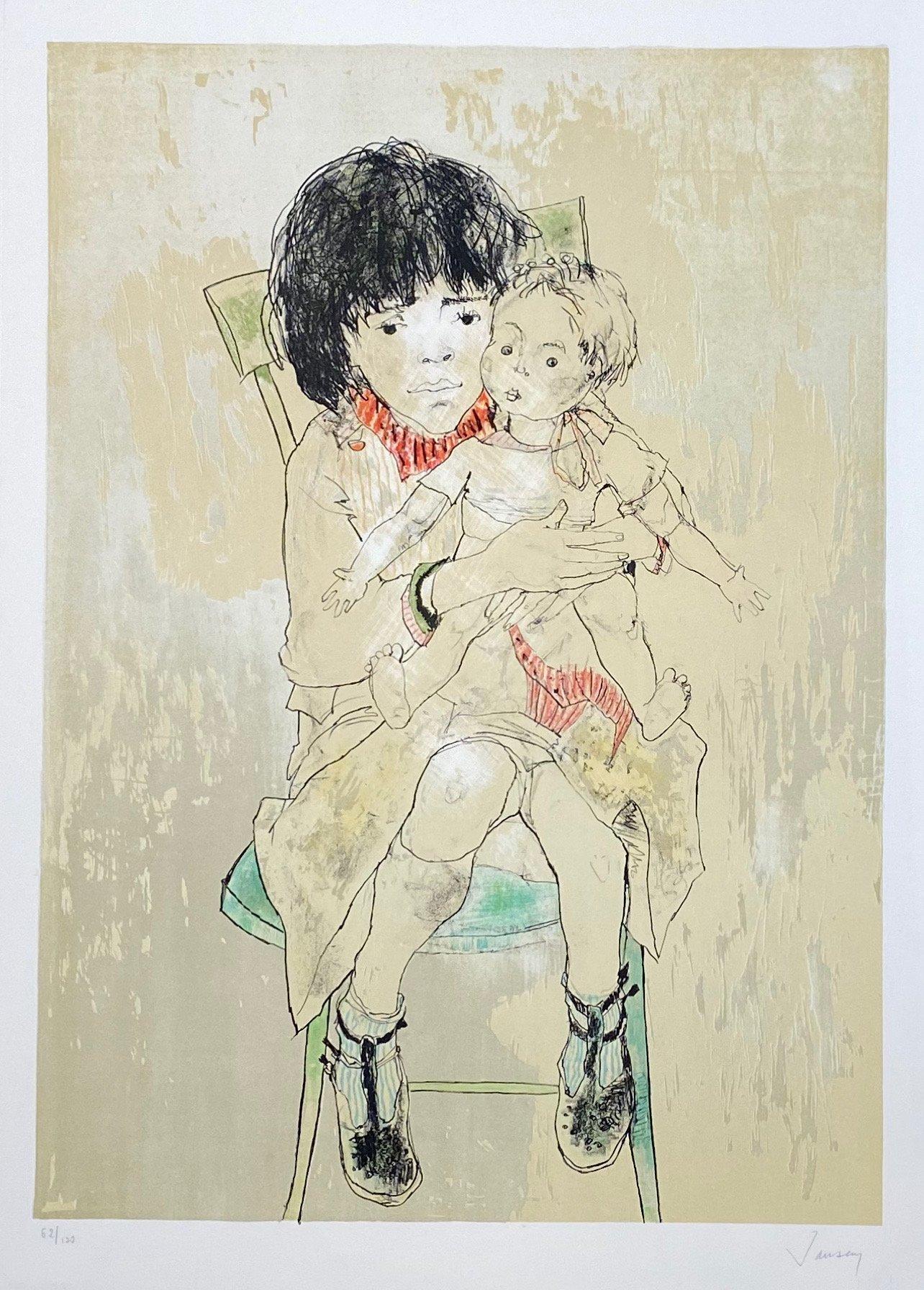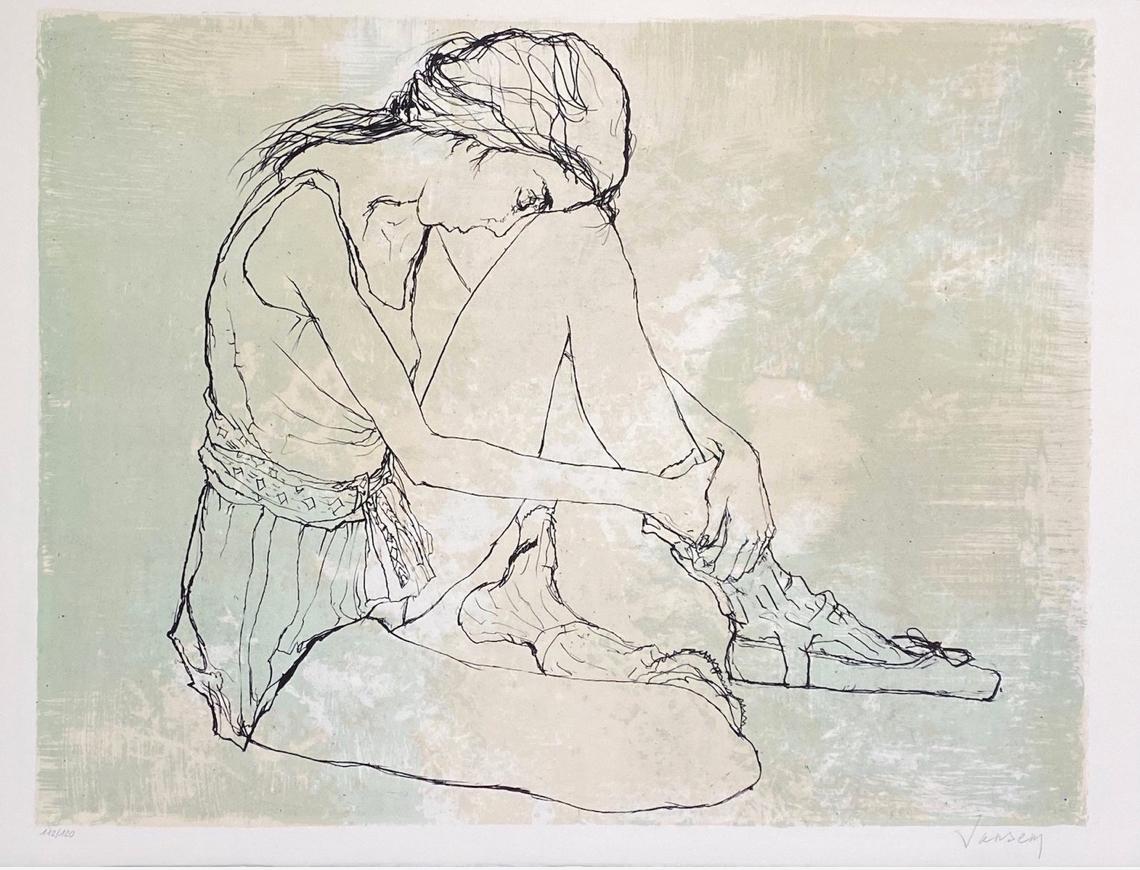Items Similar to Lithograph Israeli Modernist Judaica, Kibbutz Boy, Bezalel Artist
Want more images or videos?
Request additional images or videos from the seller
1 of 8
Moshe GatLithograph Israeli Modernist Judaica, Kibbutz Boy, Bezalel Artistc.1960
c.1960
About the Item
A signed and numbered lithograph print.
Moshe Gat was born in Haifa in 1935.
in 1952 he began his studies at the Bezalel School, in Jerusalem.
In 1955 he returned to Haifa, where he taught drawing, and began to participate in important exhibitions being shown in Israel.
In 1957 he was awarded a grant by the America-Israel Cultural Fund, to further his studies abroad. He became a member of the Society of Painters and Sculptors in Israel, and held his first one-man exhibitions. The most important of these was in the Tel-Aviv Museum.
In 1958 he left Israel, and after an educational tour of the museums of Paris and Italy, he reached Mexico. Several months later, two of his works were accepted for the exhibition of artists of Mexico; this was part of the American Biannual, which brought together in the city the best of American art. Here, the Director of the National Museum of Modern Art saw the pictures and arranged a one-man show for Gat at the Museum of the Palace of Fine Arts in Mexico City.
In 1962 he held his first one man show at the ACA. Gallery in New York. He held exhibits too in New Orleans, Chicago, Detroit, Texas and elsewhere.
In 1962, after an absence of five years, the artist returned to Israel, and settled in Haifa. In the following year he held exhibitions at the Haifa Municipal Museum, the Bezalel Museum in Jerusalem, the Artist's House in Haifa, and Jerusalem, the Chermerinsky Gallery in Tel Aviv, and other places all over the country. These exhibitions mainly included works produced abroad, many of which were borrowed from private collections. In 1962 he began to teach drawing at the Bezalel School in Jerusalem.
The First Exhibition of Israeli Graphic-Art, Museum for Modern Art, Haifa, 1967.
Artists: Ullman, Micha Steinhardt, Jakob Rothman, Aryeh Pins, Jacob Smilansky, Noemi Sima, Miron Moreh, Mordecai Lehmann, Rudolph (Rudi) Lahav-Shaaltiel, Ora Yaskil, Avraham Tamir, Moshe Weiss, Joseph Hoffman, Moshe Gat, Moshe Gross, Michael Glass, Ari Bacon, Yehuda Ben Shaul, David (Dedi) Beeri, Tuvia Aschheim, Isidor
Moshe Gat took part in the international exhibition at the Metropolitan Fine Art Gallery in Tokyo, where his woodcut "Three Old Women" won the prize for graphic art.
He was one of the twelve Israeli artists whose works were shown also at an exhibition held at Pushkin House in Moscow, early in 1965.
In 1965 he exhibited at the "Mer Kup" Gallery in Mexico City.
- Creator:Moshe Gat (1935)
- Creation Year:c.1960
- Dimensions:Height: 27 in (68.58 cm)Width: 20.5 in (52.07 cm)
- Medium:
- Movement & Style:
- Period:
- Condition:toning to mat and edge, minor wear. wear to frame size includes frame.
- Gallery Location:Surfside, FL
- Reference Number:1stDibs: LU38213171912
About the Seller
4.9
Platinum Seller
These expertly vetted sellers are 1stDibs' most experienced sellers and are rated highest by our customers.
Established in 1995
1stDibs seller since 2014
1,560 sales on 1stDibs
Typical response time: 1 hour
- ShippingRetrieving quote...Ships From: Surfside, FL
- Return PolicyA return for this item may be initiated within 3 days of delivery.
More From This SellerView All
- Jewish Rabbi with Torah German Expressionist Woodcut Israeli Early BezalelBy Jacob SteinhardtLocated in Surfside, FLHand signed in pencil, woodblock print woodcut. Jacob Steinhardt 1887-1968 Steinhardt, Jakob, Painter and Woodcut Artist. b. 1887, Yaacov Steinhardt was born in the then remote,...Category
20th Century Expressionist Figurative Prints
MaterialsWoodcut
- Jakob Steinhardt Jewish German Expressionist Lithograph Israeli Early BezalelBy Jacob SteinhardtLocated in Surfside, FLplate signed. Jacob Steinhardt 1887-1968 Steinhardt, Jakob, Painter and Woodcut Artist. b. 1887, Yaacov Steinhardt was born in the then remote, largely Polish town of Zerkow in the Posen District of Germany. (poland/german) Immigrated 1933. Studies: 1906 School of Art, 1906 Studied in Berlin Arts and Crafts School. Berlin; 1907 painting with Lovis Corinth and engraving and etching with Hermann Struck; advanced studies, 1908-10 Paris, with Henri Matisse and Steinlen; 1911 Italy. Teaching: Bezalel, Jerusalem, 1953-57 Director. 1910 Participated in the “New Sezession”, Berlin. 1912 together with Ludwig Meidner and Janthur he founded the "Pathetiker" group very early in the German expressionist movement. Running afoul of the Nazis, he fled to Tel-Aviv and then Jerusalem in the early 30s, showing in “Der Sturm” Gallery. 1914 Exhibited with ludwig Meidner at first Expressionist Exhibition in Berlin. Worked mainly in woodcuts depicting biblical and other Jewish subjects. 1955-58 International awards for his woodcuts. receives graphic commissions from Fritz Gurlitt. 1922 Marries Minni Gumpert. Active in organizing Secession exhibits. 1925 Trips to Mark Brandenburg and Holy Land. Turns primarily to painting; stops work on etchings and lithographs. 1933 Emigrates to the Palestine. 1934 Moves to Jerusalem and opens an art school; attempts some etchings. 1948 Closes the art school and becomes Chairman of Graphics Department, Bezalel School for Arts and Crafts. 1954-57 Director of Bezalel School for Arts and Crafts. Taken up by J. B. Neumann who became the agent for his etchings. Exhibited Sturm Gallery, Herbst-salon. 1914 Outbreak of World War I; Steinhardt enlists in German army. 1916-18 First on Eastern Front in Poland and Lithuania, then after short training period in Berlin, sent to Macedonia. 1917 Exhibition of Lithuanian drawings at Berlin Secession in Spring. Elected member of the Secession. He often used wood-cutting techniques that were popular amongst German Expressionists. Steinhardt was driven to express ideas clearly and decisively through art. Amongst the themes found in his work the prophets of the Bible, such as Jonah, are noticeable. Steinhardt identified deeply with Jonah due to his attempt to run from God's call to duty. Additionally, the image of beggars was often found in Steinhardt's works and in his artistic presentation of the less fortunate, the artist's love for his fellow man becomes evident. Moreover, the grotesque was a theme noticeable in Steinhardt's earliest pieces. These were fantastical images; it was unclear whether or not they were human or demon. In the 1950's, Steinhardt returned to these images upon learning of the Holocaust of Europe's Jews. At that time he resided in New York and there, in the shadow of the skyscrapers, Steinhardt's reaction to WWII was expressed through his art. A Collection of Works by Artists of the Land of IsraelThe Bezalel National Museum, Jerusalem 1940 Artists: Shemi, Menahem Rubin...Category
20th Century Expressionist Figurative Prints
MaterialsWoodcut
- Dutch Fantastic Modern Etching, Jan Mensinga Old Master Style Wine Maker, GrapesLocated in Surfside, FLJan Roelf Mensinga, Dutch artist, painter, graphic printmaker, watercolor artist. (born Leeuwarden 1924 - 1998 Amsterdam) Education: Mensinga attended an art studies from 1954 to 1...Category
20th Century Expressionist Figurative Prints
MaterialsEtching
- Steinhardt Woodcut Marian Anderson Signed African American, Israeli Bezalel ArtBy Jacob SteinhardtLocated in Surfside, FLPortrait in black and white, woodblock print. Pencil signed by both Jacob Steinhardt 1887-1968 and Marian Anderson. Very rare thus. (Commissioned by Dr. Leon Kolb, San Francisco) 3...Category
1950s Expressionist Figurative Prints
MaterialsWoodcut
- Hungarian Modernist Judaica Etching Print Teffilin, Jewish Rabbi in PrayerBy Janos KassLocated in Surfside, FLFrom very small edition of 15 on handmade mould made paper, with Jewish star Magen David watermark. From the deluxe boxed portfolio edition. Hand signed in pencil. János Kass (December 26, 1927 – March 29, 2010) was a Hungarian illustrator, printmaker, graphic designer, postage stamp designer, animated film director and teacher. Hungary's foremost graphic artist and book illustrator. Born in Szeged, he was the storyboard artist for the first fully digital animated film. This is done in a manner reminiscent of Saul Raskin, Tully Filmus and William Gropper, this is a modern take on a classic judaic subject matter, similar in style and tone to Abram Krol, Jakob Steinhardt, Josef Budko and Hermann Struck. Beginning his artistic studies at the Applied Art Academy, Kass finished in 1951 at the Academy of Fine Arts, a student of Gyula Hincz, György Kádár and György Konecsni. From 1956 to 1959 he held the Derkovits scholarship. From 1961 to 1962, he was assistant professor at the Book-Art Academy in Leipzig, Germany. Kass regularly took part in every major national exhibition at home and abroad. He had one-man shows in Italy (1963), Australia (1970) and Switzerland (1976). He participated in the Venice Biennial (1960), the Youth Biennial in Paris (1961), and Biennials in Lugano, Tokyo, Ljubljana, São Paulo and Buenos Aires, along with "Intergrafik" exhibitions in Berlin. He made many friends within the British graphic art fraternity while spending some months in London during 1980, working on one of the earliest, fully digitized computer-animated films, Dilemma, with John Halas. He had already won recognition with his illustrations and book designs. At the 1973 Leipzig book fair, his work was awarded the title of best illustrated book at the fair. This accolade was repeated at the Frankfurt fair in 1999. The 11-minute Dilemma was nominated at that year's Cannes Film Festival for the Golden Palm for Best Short Film, and is considered the first fully digital animated film. Kass was also a background artist for the "So Beautiful and So Dangerous" segment of Ivan Reitman Productions' 1981 animated feature film Heavy Metal. Kass' drawings, etchings and silk-screen prints were exhibited in the Fitzwilliam Museum in Cambridge in 1989 and in 1990 at London Olympia. He later held a one-man show in Edinburgh. He illustrated something like 400 books, classical novels and children's stories, among them an elegant edition of Imre Madách's 19th-century drama The Tragedy of Man, published in Iain MacLeod's translation by Edinburgh's Canongate press in 1993. He won Hungary's highest artistic award, the Kossuth prize, and was an elected member of the Széchenyi academy. János Kass’ s numerous works can be found in the Hungarian National Gallery. Since 1985, the János Kass Gallery...Category
1990s Expressionist Figurative Prints
MaterialsEtching
- Hungarian Modernist Judaica Etching Print Kiddush, Jewish Rabbi at Shabbat FeastBy Janos KassLocated in Surfside, FLFrom very small edition of 15 on handmade mould made paper, with Jewish star Magen David watermark. From the deluxe boxed portfolio edition. János Kass (...Category
1990s Expressionist Figurative Prints
MaterialsEtching
You May Also Like
- Pèlerin au cierge, 1986, original lithograph by Jean Jansem, signed and numberedBy Jean JansemLocated in Carouge GE, GEJean Jansem (1920-2013) Pélerin au cierge, 1986 Lithographie sur papier Japon, justifiée XIV / XXX Signée en bas à droite 67 x 51 cm / 76 x 54 cm Bibliographie: CR Jansem, 1993, n...Category
Late 20th Century Expressionist Figurative Prints
MaterialsLithograph
- IVRESSE Signed Lithograph, Female Portrait, Mask Face, Dark Pink, Green, BlueBy CorneilleLocated in Union City, NJIVRESSE is an original hand drawn limited edition lithograph printed in 12 colors on archival Somerset paper 100% acid, free, by the Dutch artist known as CORNEILLE(Guillaume van Bev...Category
1980s Expressionist Portrait Prints
MaterialsLithograph
- LES DEUX AMIES Signed Lithograph, Two Friends Portrait, Dark Mauve, PeriwinkleBy CorneilleLocated in Union City, NJLes Deux Amies is an original hand drawn limited edition lithograph printed in 13 colors on archival Somerset paper 100% acid, free, by the Dutch artist known as CORNEILLE(Guillaume van Beverloo) an abstract expressionist who co-founded the 20th Century experimental art movement CoBrA recognized for their spontaneous, rebellious style of painting that was heavily inspired by the art of children and the mentally ill. Corneille devises his colorful fantastic imagery with exotic plant forms, sensuous female bodies, animals and lively pattern design. Les Deux Amies is a fantastical red outlined portrait of two people; one a frontally posed female depicted with a bright blue, wavy wedge hairdo and dark mauve face. Her colorful mask...Category
1980s Expressionist Portrait Prints
MaterialsLithograph
- Sophie aux bas rouges, 1993, original lithograph by Jean JansemBy Jean JansemLocated in Carouge GE, GEJean Jansem (1920-2013) Sophie aux bas rouges, 1993 Lithographie sur papier Arches, justifiée E/A Signée en bas à droite 66 x 50 cm / 76 x 56 cm Bibliographie: CR Jansem, 2000, n°...Category
Late 20th Century Expressionist Figurative Prints
MaterialsLithograph
- Christina et sa poupée, 1985, original lithograph by Jean Jansem handsignedBy Jean JansemLocated in Carouge GE, GEJean Jansem (1920-2013) Christina et sa poupée, 1985 Lithographie sur papier Arches Signée et justifiée 76 x 54 cm Imprimeur: Mourlot, Paris Editeur Sanbi, Tokyo Bibliographie: Jan...Category
Late 20th Century Expressionist Figurative Prints
MaterialsLithograph
- Repos, 1999, original lithograph by Jean Jansem handsigned numberedBy Jean JansemLocated in Carouge GE, GEJean Jansem (1920-2013) Repos, Album Danse, 1999 Lithographie sur papier Arches Signée et justifiée 50 x 65 cm / 54 x 76 cm Imprimeur: Mourlot, Paris Editeur: Jansem, Paris Bibliographie: Jansem Lithographe, 1993-1999, Flora Jansem, Paris, n. 155, reproduit p.81, référencé p. 97. "Ma première lithographie date de 1954. Elle représente un enfant en haillons portant deux seaux d'eau, d'après un croquis rapporté de Cordoue lors de mon voyage en Espagne en 1952. Je l'exécutai sur pierre, au pinceau et à l'encre lithographique. Je fus déçu du résultat et n'en tirai qu'un essai et une épreuve. Quatre ans plus tard, je réalisai une dizaine de nouvelles lithographies, toujours sur pierre, la plupart en noir. Au lieu d'employer l'encre et le crayon lithographiques, j'utilisai l'encre zincographique plus fluide me permettant de travailler à la plume ou avec de fins pinceaux de martre. Le tirage fut très satisfaisant. au grand étonnement du Père Guillard, lithographe. Jusqu'alors l'encre zincographique ne servait qu'à la zincographie. Actuellement elle est d'un usage courant puisque pratiquement toutes les lithographies se font sur zinc et non plus sur pierre, ce qui facilite la manipulation. Par ailleurs, le zinc offre autant de possibilités que la pierre. En 1959, La Guilde de la Gravure me demanda une édition en couleur. Je choisis une nature morte aux chardons, tirée à 220 exemplaires. Par la suite, les tirages varièrent de 10 à 160 épreuves. Mes lithographies en couleur étaient assez proches de mes toiles. A partir de 1968, période de La Danse, je supprimai petit à petit le clair-obscur et la matière pour donner plus de légèreté et de transparence. Les lithographies postérieures à 1970 sont dessinées en noir sur un fond coloré souvent volontairement arbitraire, donnant l'aspect d'un dessin rehaussé. La couleur n'est pas intégrée au dessin mais joue un rôle d'accompagnement du trait qui est lui-même une arabesque écrite. Quand le noir...Category
Late 20th Century Expressionist Figurative Prints
MaterialsLithograph
